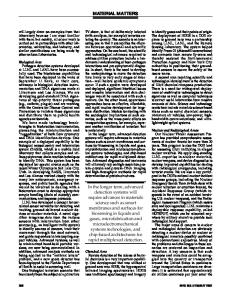Asphalt Materials Science and Technology James G. Speight
- PDF / 7,924,757 Bytes
- 2 Pages / 585 x 783 pts Page_size
- 105 Downloads / 339 Views
Asphalt Materials Science and Technology James G. Speight Butterworth-Heinemann, 2015 650 pages, $127.50 (e-book $127.50) ISBN 9780128002735
I
n a typical petrochemistry text, asphalt is depicted as a very low value byproduct, and its description is relegated to a handful of paragraphs. However, these heavy fractions of petroleum have been among the first oil-derived materials with applications in human history (e.g. caulking, jewelry adhesives, construction industry, and medicine). If one adds that this is the most common material for paving roads, the importance of asphalt becomes evident. Asphalt is a complex material, and this text is a welcome addition to the chemical literature. Chapter 1 deals with nomenclature and terminology. Petrochemistry, maybe more than other fields of chemistry,
suffers significant confusion due to a variety of common names used in several different industries and of systematic nomenclature. Chapter 2 narrates the history of asphalt, how it has been sourced, and how it has been used in different ages and places. Chapter 3 focuses on the processes that refine and transform the residua of the distillation of crude oil. Chapter 4 describes the characterization methods of the hydrocarbon fraction and the potential modifiers that compose asphalt mixes. Chapter 5 centers on the testing of the aggregate that is mixed into the asphalt for manufacturing the pavement/tarmac laid on the road. Chapters 6 and 7 cover asphalt chemistry and systematize the complexity of
the composition and of the interactions between several constituents of this material. Asphalt technology is described in chapters 9–11, which cover the formulation and techniques for laying an efficient road pavement. Asphalt’s environmental issues, such as waste disposal or recycling, are discussed in chapter 12. A set of appendices completes the book, along with a list of all of the American Society for Testing and Materials and American Association of State Highway and Transportation Officials standard test methods related to asphalt, and a complete glossary. Each chapter is self-contained and can be read separately from the others. Material engineers exploring the applications of asphalt will find value in this book. Chemists working in the petrochemical industry, analysts involved in the characterization of petrochemicals, and forensic scientists working in failure and compliance assessment will also find this text useful. Reviewer: Valerio Causin of the University of Padova, Italy.
• VOLUME BULLETIN 41 • ofNOVEMBER 2016 •atwww.mrs.org/bulletin Downloaded from https:/www.cambridge.org/core. IP address: 80.82.77.83, on 08 Mar 2017 at 20:10:23, subject MRS to the Cambridge Core terms use, available https:/www.cambridge.org/core/terms. https://doi.org/10.1557/mrs.2016.265
921
Become an MRS Congressional Science and Engineering Fellow! Help improve the interface between science and legislative decision making. Advocate for policies that will facilitate the discoveries of the future. Play a crucial role as you educate the pu
Data Loading...











